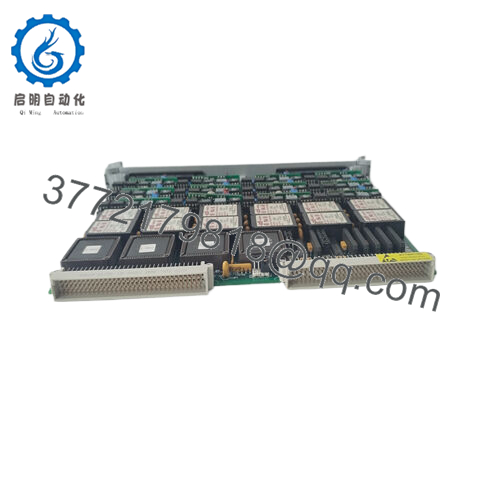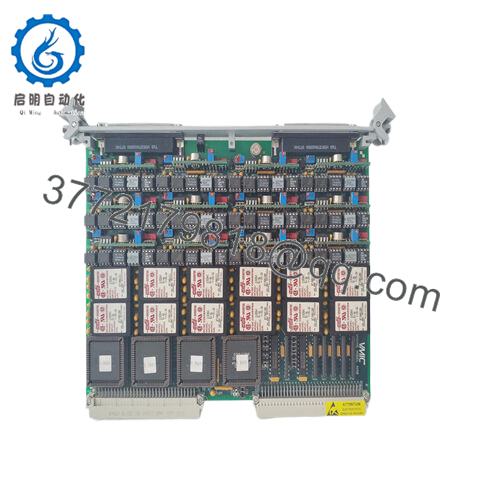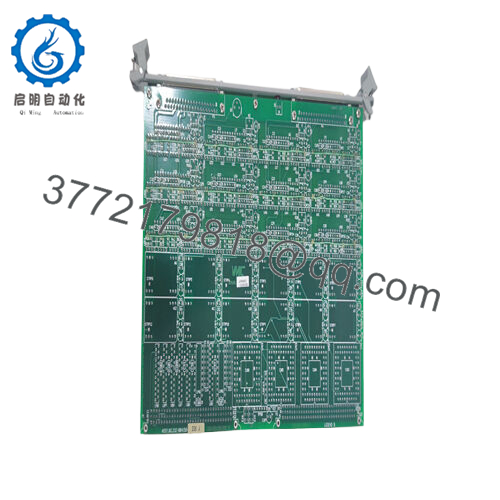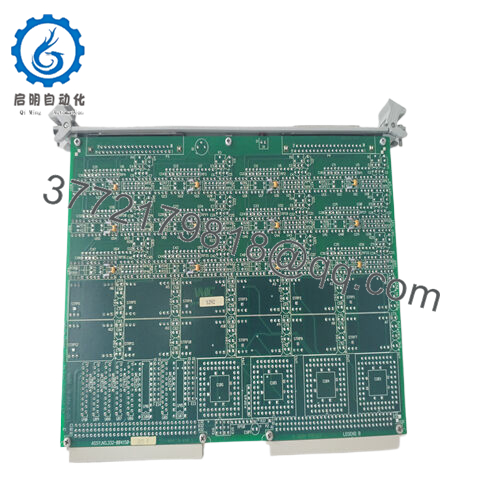Description
In the unforgiving expanse of real-time industrial control, where a fleeting digital input glitch from field sensors can unravel synchronization in turbine sequencing or motor drives, engineers contend with the fragility of signal acquisition that buckles under electrical transients, ground shifts, or high common-mode voltages in sprawling automation networks. The GE VMIVME-4150 emerges as a fortified 64-channel digital input module from GE Fanuc’s VMIC series, precision-crafted to ingest high-voltage discrete signals with unyielding isolation, ensuring process control integrity in environments where every bit flip risks operational cascades. Consider a steel mill’s rolling stand, where proximity switches and limit detectors pulse amid inductive noise from arc furnaces, demanding robust I/O signal handling to avert mistimed shears; or a semiconductor fab, where ESD-sensitive interlocks require high-reliability isolation to maintain cleanroom uptime without false triggers from static buildup. These are the pressure points where system stability falters on inadequate buffering, inflating debug cycles and exposing modular integration seams in VMEbus architectures.
- VMIVME-4150
- VMIVME-4150
The GE VMIVME-4150 counters this by prioritizing the user’s core aim of signal reliability, channeling up to 64 single-ended or 32 differential inputs at voltages from 5 to 60 V DC, with optical isolation that severs noise paths while supporting interrupt generation for time-critical events. In standard deployments—like augmenting legacy VME chassis for enhanced diagnostics in power plant SCADA or embedding into modular I/O stacks for military sims—it asserts necessity, outpacing discrete optos or under-isolated PLC slices that clutter backplanes and compromise scalability. Sans this module, setups devolve into ad-hoc patches—unshielded TTL converters or cascaded buffers—that amplify vulnerabilities and hinder high-reliability pursuits in process control realms governed by MIL-STD-1553 or IEEE 1014. The GE VMIVME-4150, by contrast, embeds change-of-state detection and debouncing logic, enabling proactive polling that syncs with host CPUs for streamlined fault tree analysis.
Its advisory acumen appeals to integration leads tackling hybrid systems: A/D conversion hooks for voltage monitoring, plus VME64 compatibility, foresee the engineer’s navigation of bus arbitration in multi-slot cages. For search-attuned pros eyeing “VME digital input module” or “GE VMIC high voltage I/O,” it surfaces as a bastion of dependability. If your automation quandaries center on corralling volatile discrete streams for flawless execution in EMI-saturated zones, the GE VMIVME-4150 transmutes those perils into precise conduits, tethered to vetted resilience that refines deployment discernment.
When forging the input layer of a VME-based control scaffold, the savvy module doesn’t just latch bits—it discerns their context, filtering transients to feed the bus with veracity that sustains upstream algorithms without engendering overruns or stale reads. The GE VMIVME-4150 realizes this as a 64-channel HV digital input board in GE Fanuc’s VMIC arsenal, capturing field pulses via screw-terminal front panels or optional transition modules, where each channel’s optocoupler array clamps common-mode rejection to 500 V while debouncing edges at programmable 1-16 ms intervals to quash contact bounce. It dispatches this to the VMEbus via dual-edge D-type latches, supporting A24/A32 addressing for scatter-gather DMA transfers, and asserts interrupts on vectors like IRQ2 for host notification, all orchestrated by an onboard PLD that offloads polling from the CPU.
Within the automation continuum, it resides at the peripheral tier, plugging into P1/J1 slots of Eurocard cages to liaison rugged sensors—think 24 V NAMUR switches or 48 V solenoids—with core processors like the PowerPC or i386, while embracing VME64x extensions for 2eVME burst modes in high-throughput loops. Diagnostics integrate fluidly: status registers expose input states via memory-mapped I/O, with fault LEDs per bank signaling overvolt or fuse blows, queryable over VSB for chassis-wide syndication. It converses in VME protocols, from block transfers for bulk scans to ROAK for atomic reads, easing dovetails with reflective memory nodes or PMC carriers in fault-tolerant setups where triple-voting inputs demand sub-10 µs latency.
Practically, it commissions with tactical finesse—seat it in slot 1 of a 6U crate, route field wiring through a VMIVME-9905 breakout for strain relief, and map registers via the VxWorks or LynxOS driver kit, its quiescent pull under 10 W suiting fan-cooled enclosures in ambient swings to 70°C. The GE VMIVME-4150 surpasses mere acquisition; it’s a discerning gatekeeper in your stack’s interchange, prognosticating input verity to buttress the VME fabric against the capricious.
| Specification | Details |
|---|---|
| Model Number | VMIVME-4150 |
| Brand | GE Fanuc (VMIC) |
| Type | 64-Channel High-Voltage Digital Input Module |
| Input Voltage | 5-60 V DC |
| Operating Temp Range | 0°C to 70°C |
| Mounting Style | VMEbus Eurocard (6U form factor) |
| Dimensions | 233 mm x 160 mm x 20 mm |
| Weight | 0.4 kg |
| Interface/Bus | VMEbus (A24/A32, D8/D16/D32) |
| Compliance | VME64, IEEE 1014, CE |
| Supported Protocols | VME interrupt handlers, ROAK |
| Typical Power Draw | ≤ 10 W |
Embracing the GE VMIVME-4150 infuses your VME ecosystem with an input tenacity that echoes through the chassis, launching with its isolation ramparts that quarantine field clamor, where inductive kicks or ESD transients might otherwise latch errant states and seed sequence faults. In the ceaseless barrage of industrial polling, this anchors performance consistency by latching true transitions amid 100 kHz noise floors, eluding the state flips that erode sync in servo loops—envision upholding 99.9% fault coverage during ramp-ups without the haze of unfiltered chatter, often amplifying MTBF in sensor webs by weeding bounce artifacts. It’s the tacit arbiter that liberates CPUs for higher-order tasks, channeling vetted discretes to fuel PID tunings or state machines sans auxiliary debounce.
Tendency patterns hone distinctly, as its PLD diagnostics—surfacing bank faults or voltage excursions via VME reads—facilitate foresight audits relayed to console logs, priming swaps over scrambles and condensing floor time in distributed crates. The module’s svelte footprint streamlines this, populating dense racks alongside A/D siblings to pare engineering exertions in expansions, whether densifying a testbed for avionics or meshing with PMC I/O for radar feeds. Tailored for stamina, the wide input span and fused channels defy surge incursions, vowing sustained potency that outlives jury-rigged arrays and eases MIL-STD-1399 proofs with inherent edge triggering.
In essence, this board’s forte proliferates through architectural affinity, where latched vectors illuminate event chains for anomaly hunts, facilitating conformity to DO-178B. For the engineer adjudging crate evolutions amid throughput tugs, the GE VMIVME-4150 winnows high-reliability into palpable yields—fewer glitches, keener telemetry, and a phalanx that elevates input stewardship from task to triumph.
The GE VMIVME-4150 assimilates smoothly into aerospace ground stations, where it aggregates 64 limit inputs from hydraulic actuators amid RFI from transmitters, its VME interrupts cueing real-time sims for TMR-voted permissives that secure critical system uptime in process control environments questing for DO-254 airworthiness—crucial for quashing false enables during flight envelope tests.
In oil rig drilling controls, it interfaces 48 V solenoids and pressure switches in ATEX enclosures, its debouncing withstanding 5g vibes while feeding VxWorks kernels for blowout preventer logic, fortifying high-reliability chains that nix spurious clamps in fast data cycles.
Extending to automotive test dynamometers, the module polls encoder discretes in EMI vaults, its A32 maps dissecting shift transients for ECU validation sans latency. Whether used in power plants or VME I/O realms, the GE VMIVME-4150 steels stringent-condition vigils, melding channel depth with bus adroitness for resilient, tempo-attuned ventures.
VMIVME-4150-250 – High-voltage variant with enhanced 250 V isolation for arc-prone industrial inputs in VME stacks.
VMIVME-4150-365 – 32-channel A/D companion for hybrid analog-digital acquisition in sensor fusion setups.
VMIVME-4150-415 – Reflective memory interface add-on for deterministic data sharing across VME nodes.
VMIVME-1182 – Legacy digital I/O sibling with 96 channels for cost-effective expansions in legacy crates.
VMIVME-7800 – Power supply module to stabilize feeds for VMIVME-4150 in multi-slot configurations.
VMIVME-9905 – Transition board for front-panel wiring, easing field terminations alongside the core module.
VMIVME-4514 – Analog output counterpart for balanced I/O in closed-loop VME control loops.
Before slotting the GE VMIVME-4150 into its crate, a crisp congruence check can forestall those boot-time bafflers that drag timelines. Tally VME slot geometry with the chassis manifest per GE’s pinout codex—misalignments breed bus errors, so enact a geo-address probe on a spare frame with a logic analyzer tap. Slot positioning tells; reserve J1/J2 access for P2 extensions if differential mode beckons, and in rack-dense bays, secure 10 mm slot gaps to foster airflow, lest localized heat skew opto thresholds past 70°C. Assay the +5 V rail for <50 mV ripple under idle scan—droops provoke latch resets—and validate ground daisy-chains to chassis to mute common-mode hum from wire runs.
In the fray, curation bends to insightful, phased glimpses that exploit its self-sufficiency. Monthly register peeks—via VME readouts for state masks or IRQ logs—unveil channel drifts or fuse trips prematurely, pluckable through host queries over bench incisions. Semiannually, inspect screw terminals for torque (0.5 Nm) and isolation resistance amid dusty cycles where arcing lurks; bolt on a debounce assay with pulse generators to recalibrate edge times. Yearly, invoke a comprehensive scan in the driver suite, emulating input storms to benchmark interrupt latency against spec sheets—align with any bulletin drops from the archive for bus evolutions. In vibratory or humid outposts, a quarterly conformal refresh over optos repels creep without voiding seals. These aren’t imperious; they’re keyed to your VME’s cadence, sustaining sharpness while diverting drive to iterations over incidents.






 WhatsApp: +86 16626708626
WhatsApp: +86 16626708626 Email:
Email:  Phone: +86 16626708626
Phone: +86 16626708626


